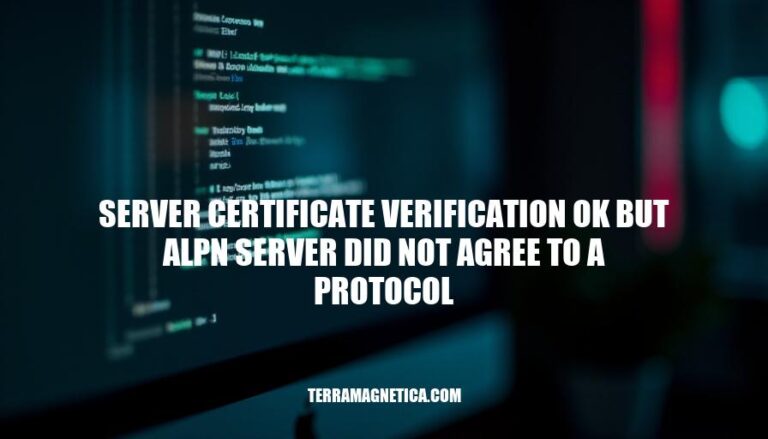


The issue “server certificate verification OK but ALPN server did not agree to a protocol” occurs during secure communications when the server and client fail to agree on a protocol via Application-Layer Protocol Negotiation (ALPN). This can lead to fallback to a less preferred protocol, potentially impacting performance or security. It’s crucial in ensuring that both parties can communicate securely and efficiently using the most suitable protocol.
Server Certificate Verification Process:
Importance: This process ensures the client is communicating with the intended server, preventing man-in-the-middle attacks and ensuring data integrity and confidentiality.
Context of ‘server certificate verification ok but alpn server did not agree to a protocol’:
Application-Layer Protocol Negotiation (ALPN) is a TLS extension that allows the application layer to negotiate which protocol should be used over a secure connection during the initial handshake, avoiding additional round trips.
In secure communications, ALPN helps determine the protocol (e.g., HTTP/2, HTTP/1.1) to be used after the TLS handshake. When you see the message “server certificate verification ok but ALPN server did not agree to a protocol”, it means the server’s certificate is valid, but the server and client couldn’t agree on a common protocol to use.
: Wikipedia
: MDN Web Docs
: KeyCDN Support
Here are some common reasons why you might encounter the “server certificate verification ok but ALPN server did not agree to a protocol” error, along with examples and scenarios:
Protocol Mismatch:
Outdated Client or Server Software:
Intermediate Proxies or Load Balancers:
Security Policies:
These scenarios illustrate how mismatches in protocol support, configuration issues, outdated software, intermediary devices, library limitations, and security policies can lead to the “ALPN server did not agree to a protocol” error.
These steps should help you troubleshoot and resolve the issue.
The issue “server certificate verification OK but ALPN server did not agree to a protocol” can impact secure communications and data integrity in several ways:
Protocol Mismatch: ALPN (Application-Layer Protocol Negotiation) is used to select the application protocol during the TLS handshake. If the server does not agree to a protocol, it may fall back to a less secure protocol, potentially exposing the connection to vulnerabilities.
Downgrade Attacks: Without ALPN agreement, there’s a risk of downgrade attacks where an attacker forces the use of a weaker protocol, compromising the security of the communication.
Interoperability Issues: This mismatch can cause interoperability issues between clients and servers, leading to failed connections or degraded performance, which can affect data integrity and the reliability of secure communications.
User Experience: Users may experience disruptions or slower connections, which can undermine trust in the security and reliability of the service.
The issue “server certificate verification OK but ALPN server did not agree to a protocol” occurs when the server and client fail to agree on a protocol via Application-Layer Protocol Negotiation (ALPN), leading to potential performance or security impacts.
This process ensures secure communications by verifying the server’s certificate, checking for expiry date, domain name match, and proper signing by a trusted Certificate Authority (CA).
The impact of unresolved issues includes protocol mismatches, downgrade attacks, interoperability issues, and user experience disruptions, emphasizing the importance of resolving this issue for maintaining secure communications.